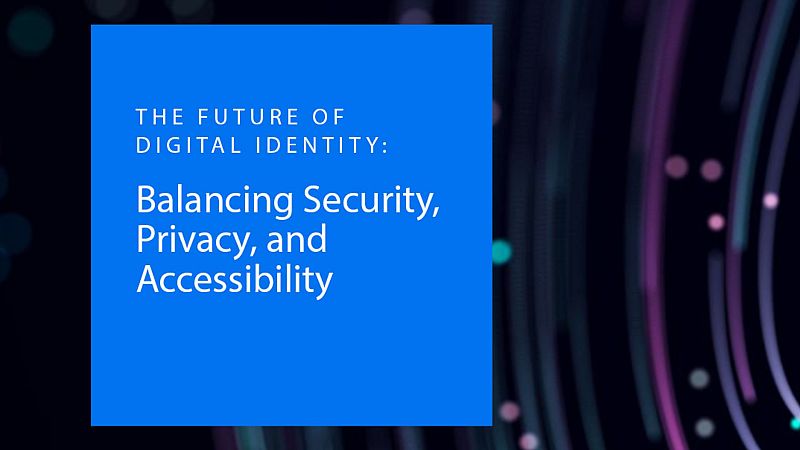
They discussed the state of digital identity today, the benefits and challenges of e-identification systems and what the future might look like for consumers, organisations and governments.
Watch the full discussion here:
As Switzerland heads towards another public vote on whether to implement a new and improved e-ID system, and the EU continues development on its EU Digital Identity Wallet, familiar questions are being raised about the role digital identities play in day-to-day life.
In Switzerland’s first round of voting, data privacy was a primary concern for the public. As part of their improved offering, the government has involved stakeholders from across the private sectors, citizen organisations and also innovators to tackle the issue.
They analysed systems used in other regions such as the EU, Canada and Bhutan to develop the thought process on how these systems should be designed.
For Daniel Säuberli, President of Digital Identity and Data Sovereignty Association (DIDAS), digital identity should be “empowerment” and users should be able to “move self-determined through the digital space and stay in control.”
“What's under the hood is actually what makes it special. There's an entire trust infrastructure being built which allows you to enrich your e-ID,” Karim Nemr, Chief Business Officer, PXL Vision, explains. “My identity is not just what I have on my passport, it's also my degrees, my journalist pass and so on.”
For businesses, e-ID is “absolutely the solution”
e-IDs are not just a consumer-facing proposition, they pose potentially big advantages for businesses too.
Agnieszka Wyszyńska-Szulc, Vice President, Regulatory, Product & ESG Policy at PMI, believes that e-IDs could be the solution for organisations when it comes to providing a secure way to ensure their products reach the right people.
Implemented correctly, they’ll be able to help with age verification, cost cutting and combating cybercrime.
Providing the system is ‘robust’ enough, e-IDs will also help prevent fraud. “For the consumer, it also brings a lot of trust and confidence if they know that we operate on a robust system,” Wyszyńska-Szulc says.
AI could prove a challenge for the future of digital identities
According to Säuberli, when it comes to AI, we are in an “information crisis.”
“When we talk about AI, aspects of misinformation, disinformation, etc. are absolutely crucial,” he explains. “What are the fundamental aspects that we can infuse into these digital ecosystems? Identity is one, but there needs to be regulation in regard to having a strategy of how identity can create value in context with the AI information crisis we are in.”
Nemr agrees, saying that with the rise of AI online use has become “very dangerous”, with artificial intelligence making it “easy to generate fake documents, fake faces and deep fakes.”
This lends weight to ensuring that e-IDs are both secure and transparent. “That’s exactly the reason why we have to build a ‘fortress’,” Säuberli says, “so that individuals can actually stay in control of the data, so that wallets are built in a way that preserves privacy.”
In his work with the Swiss government, Säuberli’s team has been prioritising the ‘unlinkability’ of a user moving across the web. The plan is for the individual to decide, based on the transaction, how much information they wish to convey.
As such, the new Swiss e-ID features default privacy principles by design to ensure users cannot be tracked.
There could be broader problems with AI’s involved in digital identification too, however. Nemr points out that additional frameworks will be needed for certifying the digital identity of machines.
“Say I built 10 AI bots to execute stuff for me,” he says, “how does the counterparty know that they actually represent me and not someone else?”
Balance between transparency and privacy crucial to citizen adoption
Striking a balance between user privacy and data control while providing an efficient service is crucial to the future of digital identity.
Säuberli emphasises that users currently have a “mistrustful mindset” when using online applications, which is critically important, and it's the job of the organisations to educate users on the need for verification systems.
He asserts. “How do you employ technology to create trusted systems that allow you to verify certain pieces of information?”
The convenience, and ultimately the usability, of these systems is also key to adoption. e-IDs can save time and hassle, as they are able to replace login credentials and negate forgotten password issues. In theory, they’re the easiest and safest digital identity option.
“I think we have the trust [of users] already which is great, but when it comes at the cost of convenience, users will choose convenience,” Nemr says.
Many Swiss voters were in favour of a 'self-sovereign’ system, whereby users have full control over their digital identity without the involvement of any third parties.
“If you want to go completely self sovereign, you need to build a completely decentralised system, which is great from an ideological perspective, but it's not practical,” Nemr says. He believes that though people say they value their data privacy, in reality, their use of things such as social media platforms contradicts that.
For Wyszyńska-Szulc, a key aspect of encouraging uptake in these schemes is highlighting lost opportunities and “the cost of rejection”. She points out that identification is not the only facet of the e-ID system, it also facilitates e-banking, e-voting and other e-government services.
“How much will this influence the country lagging behind development of technology?” she says. “I think it's an important element, which is more forward looking. It's less focussed today – on what we have here and now – but more in which direction we go, and to which extent this is the development of the economy and the society.”
Generally, user adoption will be dependent on awareness, accessibility and convenience. People need to know about it, see it everywhere and feel that it’s easy to access. Pertinently, it needs to add value for the user.
What does the future of digital identity look like?
The panellists were keen for users to see this as the first step on a journey to creating something ideal, not the ideal offering itself.
Säuberli believes in building a fundamental basis from which e-IDs can evolve, and that the Swiss public vote should focus on “the starting point, not on the perfect system.”
“We need to focus on informing the public in meaningful and transparent ways,” he expands. “It’s critical that we [build the fortress] now. There will be players who will not wait to take this role. We have to build something that allows us to still stay in control.”
For Nemr, broader trust in the internet is imperative. “[In the future] I hope we can trust the information we see in the digital world without worrying."
Säuberli echoes this, hoping that in the next five or ten years, we will have been able to “eradicate the inability to know if it’s a human or a robot on the other side. There are too many robots in the town squares today.”
Digital identity could play a crucial part here. “The internet wasn’t built with trust in mind,” Säuberli explains. “[It’s] a fundamental rethink of the foundations of the internet that’s required. I think digital identity is one of the most abstract building blocks for doing that.”
Meet the panellists:
Agnieszka Wyszyńska-Szulc - Vice President, Regulatory, Product & ESG Policy, Philip Morris International
Agnieszka joined PHI back in 2004 as part of the Corporate Affairs Team in the Polish sector of PMI before moving on through various positions within the organisation.
She attended Warsaw University where she obtained a Masters degree in Management and Administration and a postgraduate degree in Public Affairs. She also holds an Executive MBA from the Warsaw University of Technology Business School.
Daniel Säuberli - President, DIDAS
Daniel Säuberli is the President of Digital Identity and Data Sovereignty Association (DIDAS). His company’s goal is to bring the digital world to a broad range of industries and individuals so that they can easily exchange identity and related proprietary data electronically without compromising on data ownership and privacy.
DIDAS is currently working with the Swiss confederation to enhance the country’s digital trust infrastructure. Daniel studied at Harvard University and the Questrom School of Business, Boston University.
Karim Nemr - Chief Business Officer, PXL Vision
Karim Nemr has worked for PXL for more than eight years, leading the charge for a company dedicated to help improve digital safety, aid businesses through their digital transition and help make the online space more accessible for everyday users.
He has previously worked at AI Lab and in project management at Dacuda AG. He is a guest lecturer at St Gallen University and trainer and coach at Venturelab.







